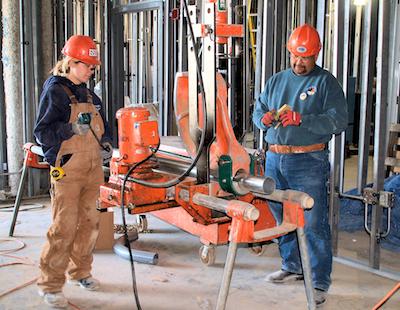Dave Fashbaugh’s jurisdiction is mostly rural, save for the influx of vacationers along Lake Michigan during the summer months.

|
| Intersections is a program developed by the Business Development Department to give local unions more tools to develop their construction market share.
|
He’s the business manager of Traverse City, Mich., Local 498, an area where organized labor’s roots aren’t nearly as deep as in and around Detroit, about a four-hour drive away. It’s a place where the recovery from the economic recession has come a little slower.
That’s why Fashbaugh asked to be included in Intersections, a program developed by the Business Development Department targeting local unions with opportunities to grow their market share. It helped Local 498 land a contract to build a Costco store -- a job that likely would have gone to a nonunion contractor in the past.
“Our people still have bills to pay,” he said. “If I sit around waiting for two or more contractors of any size to bid on a project, I’m not going to get any members because they will hit the road and not come back.”
John Bzdawka, the Sixth District’s international representative for business development, said the IBEW learned the store would be built before most potential competitors did. That allowed him and Fashbaugh to get a meeting with Costco’s head of construction and introduce him to Local 498’s signatory contractors, Bzdawka said.
The Business Development Department staff examines construction trends within a jurisdiction and identify potential opportunities. It provides a market analysis to determine what contractors have been most active in that jurisdiction during the last five years. They share the information with local business managers, who reach out to business leaders and politicians and show them why the IBEW is the right choice.
“Instead of taking a scattershot approach, how do we develop a plan to measure outcomes where everyone is moving in the same direction?” Business Development Department Director Ray Kasmark said.
Preference is given to locals where the “opportunity for growth is identified over the next 6-24 months” and “where a spirit of cooperation and innovation exists.”
Local 498 has about 125 members in the field. The goal is to increase market share in each jurisdiction and aid organizing efforts.
“Get the work, get the people, grow the local,” Kasmark said. “The next challenge is how do you keep the business going.”
Albany, Ga., Local 1531 upped its membership from 49 to more than 80 when it landed a contract to do some of the work on a Constellation biomass plant. Fifth District International Representative for Business Development Bill Dever signed an agreement promising the IBEW would supply the workers, even while knowing Local 1531 would be stretched to meet it.
It delivered. Most of the travelers in Georgia were working on a nearby nuclear plant, so the IBEW met the demand by organizing local electricians, who responded to advertising on Facebook and word-of-mouth that spread through the community.
“I’ll be the first to say that if it were not for the business development effort, we never would have been successful in landing that job,” Business Manager Allan York said. “They were already prepared to give the job to nonunion contractors.”
That project has ended, however, so York is now in search of more work. He noted his jurisdiction covers about 7,000 square miles -- more than the size of four U.S. states – but has only about 400,000 people. Potential business opportunities are harder to spot in a largely rural area, especially for a business manager at a small local without a staff.

|
A winter look at downtown Traverse City, Mich. Local 498 is using Intersections to get more work for its 125 members
Flickr/Creative Commons photo provided by XTRAICE Synthetic Ice Rinks.
|
“I am a one-man show,” York said. “I can’t spend a lot of time doing research. They are able to funnel that information to me. I can funnel that to the contractors and we can engage in some productive conversations.”
At Local 498, Fashbaugh says he’s been accepting virtually all skill levels, slotting workers into alternative job classifications.
Local 498 has run television ads and has reached applicants through its Facebook page, Fashbaugh said. A state-wide television campaign run coordinated by all the IBEW local unions in the state has helped, he said.
Bzdawka, a former Milwaukee Local 494 business manager, said strong leadership on a local level is the key to make Intersections successful.
“As long as the business manager has bought into it, it will work,” he said. “If you have someone who goes into it half-heartedly and thinks the International Office is going to sweep in and do all the work, it’s not going to fly.”
Dever said Intersections is a necessary extension of the IBEW’s capacity to provide local unions information on construction trends in real time.
“Our first question when we visit a contractor should always be, ‘What can I do to help you do that job?’” said Dever, a former business manager at Tampa, Fla., Local 915. “You need to establish a rapport and a relationship. Intersections gives you the information that plays right into it.”
The response has been gratifying for Kasmark and others involved since the program was unveiled during the IBEW’s construction conference last spring.
“The phone hasn’t stopped ringing,” he said.